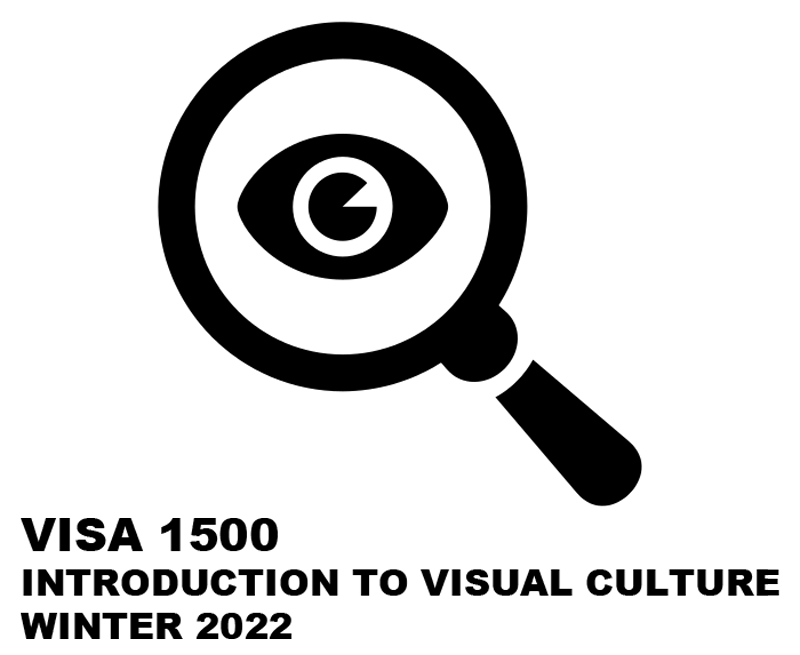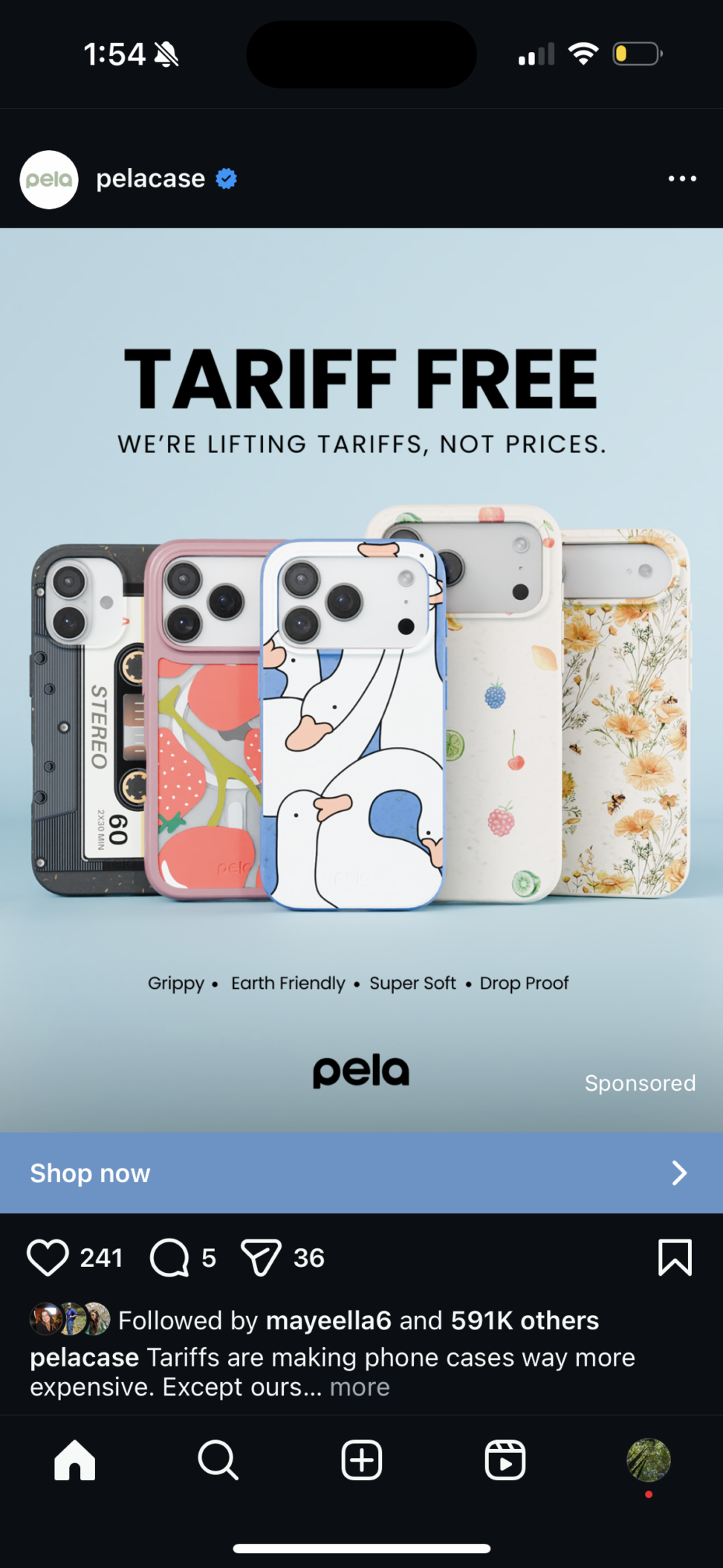Pela is a phone case and accessories brand that prides itself on being sustainable and ecofriendly. Although their advertising strategy is usually to appeal to their audience through how their brand contributes to the environment, they have recently decided to also use the fact that they are a Canadian-based company to appeal to more consumers. Even though the hook in this advertisement is that Pela is a tariff free company, it still shows the consumer that they are a sustainable brand through words, colour, and designs.
In this advertisement, the focal point is the bold text at the top that says, ‘Tariff Free,’ because the black of the text stands out against the pastel and cool tones of the rest of the image. The only other part of the advertisement that has this same effect is the brand’s name on the bottom. After the bold text, the viewer is likely to look at the phone cases which sit in the centre of the image and go horizontally across the screen. The goose phone case in the middle is the most visible and draws the most attention out of all five cases displayed. The viewer can only see parts of the other cases as they come out from behind one another towards the edges of the advertisement, making them less attention-grabbing. Despite a few of the phone cases having colours that would be considered on the warm spectrum, they come off as cool toned because the shades of the reds and yellows are pastel. The colour palette of the advertisement gives off a tranquil feeling that the consumer can associate with nature, thus bringing the advertisement back to Pela’s earth friendly intentions. Besides the cool tone of the image, the designs on the phone cases give the same effect of reminding the consumer that they are a sustainable brand. Four out of five of the phone case designs have something to do with nature, whether this be wildlife, fruits, or plants; However, only the case on the far left does not fit into this theme. It is likely that the singled-out phone case does not fit the theme as to show the viewer that Pela offers phone cases for all types of people, ones with different interests and ones with different types of phones. The last thing the viewer may notice about this advertisement is the smaller writing directly above and below the phone cases. This text is information given to the viewer that Pela considers important about their product and their values, the viewer can then decide if they want to check out the company’s website for more information or not.
I believe that there is more that could have been said in this advertisement to show what the company is about. Nowhere in the image do they display that they are a Canadian brand, and nowhere do they give more reasoning as to why people should buy these cases; except for the few words displayed below the products. I also believe that this advertisement could have been more appealing if it was more symmetrical in what is shown of the phone case designs, as the phone cases on the right side have a lot more negative space on them compared to the cases on the left. Despite what the advertisement is lacking, it does a good job at subtly implying to the viewer, through colour and patterns, that these products are environmentally friendly.
Before receiving advertisements about Pela phone cases, I had only heard of them through my environmentally conscious friend. My barely surface-level knowledge on the company before digging deeper was that they are Canadian and that they create phone cases that are biodegradable. In an interview with Pela’s founder, Jeremy Lang, he talked about having the idea in the back of his head from a young age about using flax straw as a resource for something because the fibre is so strong; he later decided he wanted to create a brand that was sustainable after seeing how much pollution was in the ocean while on vacation in 2009.(1) With the world being primarily technology driven in the current day; it is very common for most people to have phones. With these phones, the user will want a phone case to protect their device. Through wear of regular plastic phone cases, the case will slowly deteriorate and microplastics will spread onto the person’s hands and later their environment. This spread of microplastics contributes to health and environmental defects.(2) Although at first glance, consumers may believe that Pela is another greenwashing company, this couldn’t be farther from the truth. Pela has made multiple goals to reduce their greenhouse gas emissions during the different processes they use to create their products. Currently, the company has six on-going goals and five completed goals.(3)
Plastic can be found everywhere we look, “the very properties that make plastic so useful also mean that once plastic enters the environment, it will remain there for hundreds of years or longer.”(4) Not only are Pela cases biodegradable, but they also are trying to reduce plastic waste through their Pela 360 program. In this program, when customers buy a Pela case, they can return one of their old plastic cases to Pela and they will either reuse the case or make sure it gets recycled properly.
Bibliography
Kenneth. “A Biodegradable Phone Case: an Interview with Pela Case’s Jeremy Lang.” Wehl (blog), May
17, 2018. https://blog.wehl.com/biodegradable-phone-case-interview-pela-case-jeremy-lang/.
Li, Qilu, Meng Yuan, Yuan Chen, et al. “The Neglected Potential Source of Microplastics from Daily
Necessities: A Study on Protective Mobile Phone Cases.” Journal of Hazardous Materials 441
(January 2023): 129911. https://doi.org/10.1016/j.jhazmat.2022.129911.
“Pela Case | A Climate Label Certified Brand.” Change Climate. Last modified 2024.
https://explore.changeclimate.org/brand/pela.
Britta Denise Hardesty, Kathryn Willis, Justine Barrett, and Chris Wilcox. Ending Plastic Waste :
Community Actions Around the World. Clayton South, VIC: CSIRO PUBLISHING, 2023.
https://research.ebsco.com/linkprocessor/plink?id=0eda9cfa-aeb4-3804-abe3-705b408f696b.


Senna Rock
Sheyanne has done an excellent job at depicting the image. She has broken it down into the different aspects and formal elements of which the advertisement showcases. This makes it easy for the reader to follow and visualize what is going on in the advertisement. She then gives a brief backstory explaining who the founder is, what his drive was for starting the company and how his passion for sustainability shaped the company. The three main points that stood out to me in her writing were, the design and uniqueness of Pela cases, biodegradable properties regarding the physical case and the Pela 360 program. Pela prides itself in making unique designs that stand out with many of their designs relating back to nature. This showcases how they view the environment, wanting to incorporate these designs. The second main point that was made in her writing was the eco-friendly materials in which these phone cases. They are made from flax straw which then makes these cases 100% biodegradable. Her final point mentions the Pela 360 program. This program is ultimately trying to reduce old phone cases from going to into the garbage by offering a way in which customers can send them to the company to be reused or recycled. Finally, the sources that Sheyanne has provide with her essay consist of two scholarly sources and two articles. The one piece of feedback that I will give is, her thesis statement could have been stronger. The thesis statement should clearly state what the writer’s main argument is and in this case as the reader I was unsure what that was. In conclusion, Sheyanne has written a quality analysis on Pela phone cases.